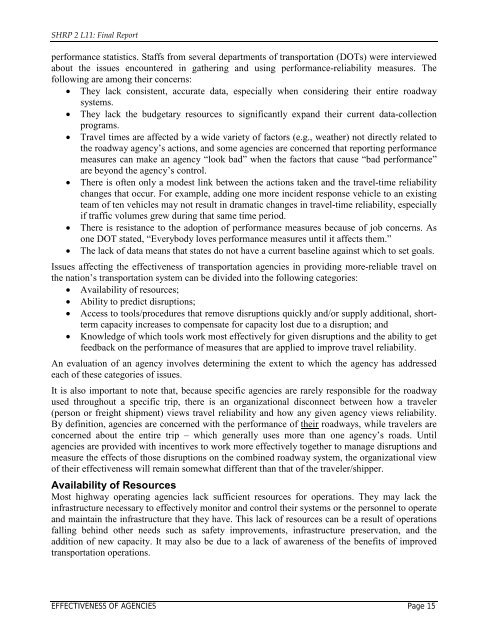Evaluating Alternative Operations Strategies to Improve Travel Time ...
Evaluating Alternative Operations Strategies to Improve Travel Time ...
Evaluating Alternative Operations Strategies to Improve Travel Time ...
Create successful ePaper yourself
Turn your PDF publications into a flip-book with our unique Google optimized e-Paper software.
SHRP 2 L11: Final Report<br />
performance statistics. Staffs from several departments of transportation (DOTs) were interviewed<br />
about the issues encountered in gathering and using performance-reliability measures. The<br />
following are among their concerns:<br />
• They lack consistent, accurate data, especially when considering their entire roadway<br />
systems.<br />
• They lack the budgetary resources <strong>to</strong> significantly expand their current data-collection<br />
programs.<br />
• <strong>Travel</strong> times are affected by a wide variety of fac<strong>to</strong>rs (e.g., weather) not directly related <strong>to</strong><br />
the roadway agency’s actions, and some agencies are concerned that reporting performance<br />
measures can make an agency “look bad” when the fac<strong>to</strong>rs that cause “bad performance”<br />
are beyond the agency’s control.<br />
• There is often only a modest link between the actions taken and the travel-time reliability<br />
changes that occur. For example, adding one more incident response vehicle <strong>to</strong> an existing<br />
team of ten vehicles may not result in dramatic changes in travel-time reliability, especially<br />
if traffic volumes grew during that same time period.<br />
• There is resistance <strong>to</strong> the adoption of performance measures because of job concerns. As<br />
one DOT stated, “Everybody loves performance measures until it affects them.”<br />
• The lack of data means that states do not have a current baseline against which <strong>to</strong> set goals.<br />
Issues affecting the effectiveness of transportation agencies in providing more-reliable travel on<br />
the nation’s transportation system can be divided in<strong>to</strong> the following categories:<br />
• Availability of resources;<br />
• Ability <strong>to</strong> predict disruptions;<br />
• Access <strong>to</strong> <strong>to</strong>ols/procedures that remove disruptions quickly and/or supply additional, shortterm<br />
capacity increases <strong>to</strong> compensate for capacity lost due <strong>to</strong> a disruption; and<br />
• Knowledge of which <strong>to</strong>ols work most effectively for given disruptions and the ability <strong>to</strong> get<br />
feedback on the performance of measures that are applied <strong>to</strong> improve travel reliability.<br />
An evaluation of an agency involves determining the extent <strong>to</strong> which the agency has addressed<br />
each of these categories of issues.<br />
It is also important <strong>to</strong> note that, because specific agencies are rarely responsible for the roadway<br />
used throughout a specific trip, there is an organizational disconnect between how a traveler<br />
(person or freight shipment) views travel reliability and how any given agency views reliability.<br />
By definition, agencies are concerned with the performance of their roadways, while travelers are<br />
concerned about the entire trip – which generally uses more than one agency’s roads. Until<br />
agencies are provided with incentives <strong>to</strong> work more effectively <strong>to</strong>gether <strong>to</strong> manage disruptions and<br />
measure the effects of those disruptions on the combined roadway system, the organizational view<br />
of their effectiveness will remain somewhat different than that of the traveler/shipper.<br />
Availability of Resources<br />
Most highway operating agencies lack sufficient resources for operations. They may lack the<br />
infrastructure necessary <strong>to</strong> effectively moni<strong>to</strong>r and control their systems or the personnel <strong>to</strong> operate<br />
and maintain the infrastructure that they have. This lack of resources can be a result of operations<br />
falling behind other needs such as safety improvements, infrastructure preservation, and the<br />
addition of new capacity. It may also be due <strong>to</strong> a lack of awareness of the benefits of improved<br />
transportation operations.<br />
EFFECTIVENESS OF AGENCIES Page 15















